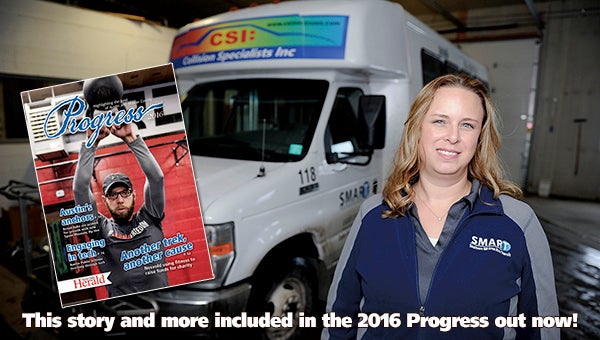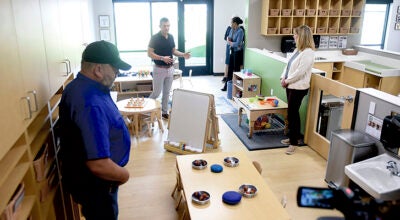Helping Austin get around
Published 11:06 am Friday, February 26, 2016
Melinda Estey told a story of a 90-year-old area woman who only recently retired. She was able to be independent and work into her 90s because she didn’t drive but could get where she needed through the Southern Minnesota Rural Transit or SMART.
Estey, SMART’s transit manager, has heard hundreds of stories like the 90-year-old woman. Without bus services, she couldn’t have kept working and doing what she loved.
“There are hundreds of stories like that where, without the bus, people would not be able to continue that independent lifestyle,” Estey said.
While many may associate public transportation with large cities like Rochester, it’s an important part of communities like Austin, Albert Lea, Owatonna and now Waseca.
Around 2012, the Minnesota Department of Transportation started work for public transit entities to consolidate and better work together. Eventually, Austin Mower County Area Transit (AMCAT), Albert Lea Transit and Steele County Area Transit (SCAT) merged in 2014 to form SMART, which is under the umbrella of Cedar Valley Services. The three agencies consolidated to reduce costs, pool resources, and provide more extensive services to the areas served.
At the start of this year, SMART added Waseca County, which was the only remaining county in Minnesota without public transit, though it had a senior travel program that mimicked public transit but received no funding.
Estey said early returns have been positive, and the community of Waseca has been receptive.
“We have no future designs to go any further,” Estey said.
Before Waseca joined, SMART provided almost 200,000 rides a year in the three counties.
Driving ridership
About 48 SMART employees operate a fleet of 31 buses and a van, which is the first that’s allowed by MnDOT for a transit authority.
Cedar Valley Services does structured workshops, training, and helps secure jobs for disabled adults, so transportation is a key hurdle for those clients. That’s why Estey said running SMART fits with Cedar Valley’s mission.
While SMART receives funding geared toward seniors, low income and disabled individuals, the transit is fully open to the public and it’s not geared toward anyone in particular.
“It’s fully open to the public, first-come, first-served,” Estey said.
The rides are important to the public. Some say they come to the communities like Austin to retire because the public transportation offers a chance to give up their car while still having the means to get to doctor’s appointments and to pick up groceries.
For the most part, Estey said their passengers are people who don’t drive, whether if it’s for a medical reason or a personal decision to not drive.
“Some seniors have standing hair appointments once a week,” Estey said.
The buses feature a bit of a social network, and Estey described it as a family feel where the riders and drivers all get to know each other. They’ve even instigated wellness checks for people who were frequent riders who may not be riding as often for some reason.
While Austin, Albert Lea and Owatonna are comparable communities, Austin has roughly double the ridership. Austin boasts 80,000 to 90,000 rides a year, while Albert Lea and Owatonna see about 45,000 to 50,000 rides a year, according to Estey.
Estey credited the community with Austin’s high ridership.
“It’s huge community support, it’s been really great initiatives over the years from partner agencies in the community,” she said.
In fact, Austin’s ridership led SMART to purchase a larger bus in 2015, but it hasn’t hit the streets yet.
Austin also has a work bus that operates up to 12 hours a day, which makes Austin the only SMART community with a bus on the road in the middle of the night five days a week.
“That’s a significant source of positive partnership,” Estey said.
Hormel Foods Corp. and Quality Pork Processors are two of the biggest beneficiaries of those services, and the work routes are a hot commodity in Austin.
“It’s very high demand,” Estey said. “We almost always have a waiting list for people to get on that bus.”
With their grant this past year, they asked for an additional hour on the work route to provide more transportation, which they received. They’re not at the point of adding an additional bus.
AMCAT also developed preschool routes through a grant with the United Way and the Parenting Resource Center, and those continue today and are being modeled in Albert Lea and Owatonna now too.
In town, demand response rides cost $2. A ride outside the city limits costs $2.50. Route buses are $1.50, but there’s also a $30 unlimited monthly pass. With an unlimited route pass, the demand response rides cost only 50 cents.
There is limited availability for countywide rides in Mower and Freeborn counties because the high population of ridership in the cities.
Routes
Another big component is reaching out in the community for educational purposes. Estey jokes that she still has friends who go, “Oh, we have buses?”
“We’re constantly trying to educate people on the availability and how to ride, the cost effectiveness, the benefits to the community,” Estey said. “The more people we can get on the bus, the more we’re helping, the more we’re helping the community and the environment.”
Rural routes is still a newer concept to rural transit, so SMART is still training people on how the routes work.
“The routes give us a huge ability to help more people,” she said. “They’re very efficient, they’re very cost effective. No one is getting rich in public transit. We’re a nonprofit, and we try to be really conscientious stewards of that money and that funding.”
Austin sees much traffic to and from Mayo Clinic Health System. The community features a Red Route and Purple Route and all are geared toward essential services: employment, medical care, shopping and housing.
They also have ridership around Riverland Community College in both Austin and Albert Lea.
“Our Red Route is extremely busy and well used, which is great,” Estey said.
Route buses stops at the same time every hour, so riders don’t need to schedule rides ahead of time. The routes also offer a three-block deviation for people who live or work within three blocks, meaning drivers can pickup or drop someone off three blocks from the route location if the rider calls at least an hour ahead of time.
Route buses cost $1.50, but there’s also a $30 unlimited monthly pass.
All services are entirely open to the public and on a first-come, first-serve basis, but SMART encourages people to arrange demand response rides as far in advance as possible for things like doctor’s appointments.
In 2014, SMART started using a routing software that arranges the customers needs for a date and time, and the system will show if they have availability on the busing to meet the need. If they can’t initially, they can tell the customer what a better time might be.
Freeborn County features one bus primarily dedicated to demand response.
Mower County has two buses dedicated to demand response from 6 a.m. to 6 p.m.
“It’s anything and everything,” Estey said.
The only inter-county route is a dialysis route on Monday, Wednesday and Friday.
Challenges
Though Estey said SMART has been successful since the merger, there are still challenges.
“The fact that we’ve been able to increase our service hours with our MnDOT grant, it’s a blessing and a curse,” she said. “Because there’s a lot of work that has to go into proving the need to add services.”
SMART’s operating budget is 80 percent state and federally funded, while it’s capital expenditures are 85 percent funded by state and federal government. Due to the funding split, they’re required to bring in 15 percent of their operating budget in each community through grants and fares. However, they strive to keep fares low so its an affordable option for their customers.
They are always looking for ways to improve services; however, the annual grant cycle can be challenging because they’re typically only able to adjust services once a year. All the changes must be defined and turned in by August, which can make it difficult when needs arrive.
They also need to define and prove the need for the changes.
“We’re spending a lot of taxpayer money, so we definitely want to make sure that we’re good stewards of that and do our due diligent research,” Estey said. “But it makes changes a little bit challenging.”
Housing for buses is a another big challenge in all the communities.
Estey said they’re also reaching their capacity in their building on the far west side of Austin on Oakland Avenue. When all the buses are in, there’s only a few feet of space.
SMART has an office off of Myers Road near the Industrial Park in Albert Lea, and it leases space in Owatonna and use space at the fairgrounds in Waseca.
Looking to the future, they’re always on top of state and federal legislation since their funding could change with the different transportation packages. They’re a member of the Minnesota Public Transit Association, which lobbies and keeps their members informed and active as to what is coming up.
Their budget is also heavily dependent on performance, which makes safety and customer relations even more important. They’re always looking to be more efficient, save fuel, and to ensure they’re meeting the needs of the community.
“We’re continuous improvement based philosophy with our system,” she said.
While she appreciates that as a taxpayer, she said it can be exhausting as they plan the the grant requests.
“Specifically the fact that we have full buses running pretty regularly is a huge testament to the success and need of the program,” Estey said. “We have a lot of people that fully depend on us and we take that very seriously.”
By the Numbers
SMART Annual Ridership for 2014: 161,255 with 477,107 miles in service
SMART Annual Ridership for 2015: 186,698 with 490,171 miles in service.
—Includes Mower, Freeborn and Steele counties.







